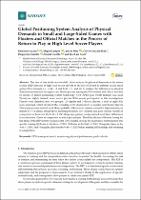Por favor, use este identificador para citar o enlazar este ítem:
https://repositorio.usj.es/handle/123456789/469
Registro completo de metadatos
| Campo DC | Valor | Lengua/Idioma |
|---|---|---|
| dc.contributor.author | Lozano, Demetrio | - |
| dc.contributor.author | Lampre, Miguel | - |
| dc.contributor.author | Díez, Adrián | - |
| dc.contributor.author | Gonzalo-Skok, Óliver | - |
| dc.contributor.author | Jaén-Carrillo, Diego | - |
| dc.contributor.author | Castillo, Daniel | - |
| dc.contributor.author | Arjol-Serrano, José Luis | - |
| dc.date.accessioned | 2021-02-12T11:59:17Z | - |
| dc.date.available | 2021-02-12T11:59:17Z | - |
| dc.date.issued | 2020-11-18 | - |
| dc.identifier.citation | Lozano, D., Lampre, M., Díez, A., Gonzalo-Skok, O., Jaén-Carrillo, D., Castillo, D., Arjol, J.L., 2020. Global Positioning System Analysis of Physical Demands in Small and Large-Sided Games with Floaters and Official Matches in the Process of Return to Play in High Level Soccer Players. Sensors 20, 6605.. doi:10.3390/s20226605 | es_ES |
| dc.identifier.issn | 1424-8220 | es_ES |
| dc.identifier.uri | https://repositorio.usj.es/handle/123456789/469 | - |
| dc.description.abstract | The aim of this study was twofold: (i) to analyze the physical demands in the return to play (RTP) process of high-level soccer players in the role of floater in different soccer sided games (SGs) formats (i.e., 4vs4 + 2 and 8vs8 + 1); and (ii) to analyze the differences in physical demands encountered by regular and floater players among the SGs formats and official matches by means of global positioning system technology (GPS APEX pod, North Ireland) was used. Twenty-six highly trained, male soccer players (U16 years) participated in this investigation. Players were classified into two groups: 23 regular and 3 floater players, a total of eight SGs were analyzed, which involved the recording of 80 observations of regular and floater players. Match-play players showed most likely–probable differences in distance covered at high-intensity per minute (D > 14.4/min), at high-speed running per minute (D > 21/min), and peak velocity (Vpeak) in comparison to floaters in the 8vs8 + 1 LSG (large-side-games), and presented most likely differences in accelerations >2/min in comparison to match-play players. Therefore, the use of floaters during the last phase of the RTP (return to play) seems to be a useful strategy for progressive reintroduction into specific training (1) floater in the 4vs4 + 2 SSG; (2) floater in the 8vs8 + 1 LSG; (3) regular player in the 4vs4 + 2 SSG; and (4) regular player in the 8vs8 + 1 LSG before starting full trainings and returning to competition. | es_ES |
| dc.format.extent | 11 p. | es_ES |
| dc.format.mimetype | application/pdf | es_ES |
| dc.language.iso | eng | es_ES |
| dc.publisher | MDPI AG | es_ES |
| dc.rights | Atribución 4.0 Internacional | * |
| dc.rights.uri | http://creativecommons.org/licenses/by/4.0/ | * |
| dc.subject | GPS | es_ES |
| dc.subject | Team sport | es_ES |
| dc.subject | Match monitoring | es_ES |
| dc.subject | Physical performance | es_ES |
| dc.subject | Peak velocity | es_ES |
| dc.title | Global positioning system analysis of physical demands in small and large-sided games with floaters and official matches in the process of return to play in high level soccer players | es_ES |
| dc.type | info:eu-repo/semantics/article | es_ES |
| dc.subject.unesco | Investigación | es_ES |
| dc.identifier.doi | 10.3390/s20226605 | es_ES |
| dc.rights.accessrights | info:eu-repo/semantics/openAccess | es_ES |
| Aparece en las colecciones: | Artículos de revistas | |
Ficheros en este ítem:
| Fichero | Descripción | Tamaño | Formato | |
|---|---|---|---|---|
| Global positioning system analysis of physical demands in small and large-sided games with floaters.pdf | 1,18 MB | Adobe PDF |  Visualizar/Abrir |
Este ítem está sujeto a una licencia Creative Commons Licencia Creative Commons

